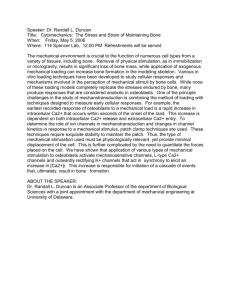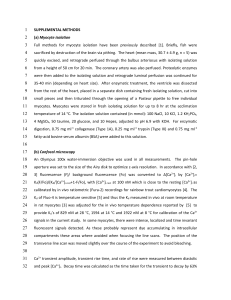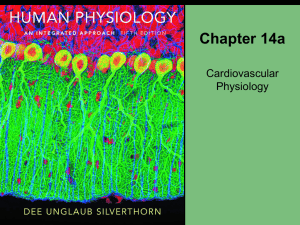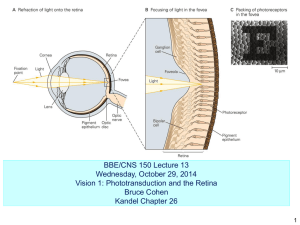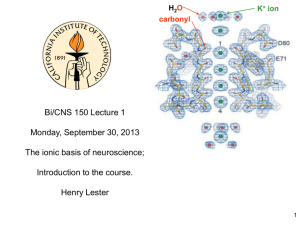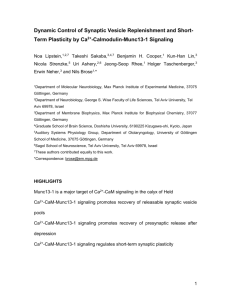S2 Text - PLoS ONE
advertisement
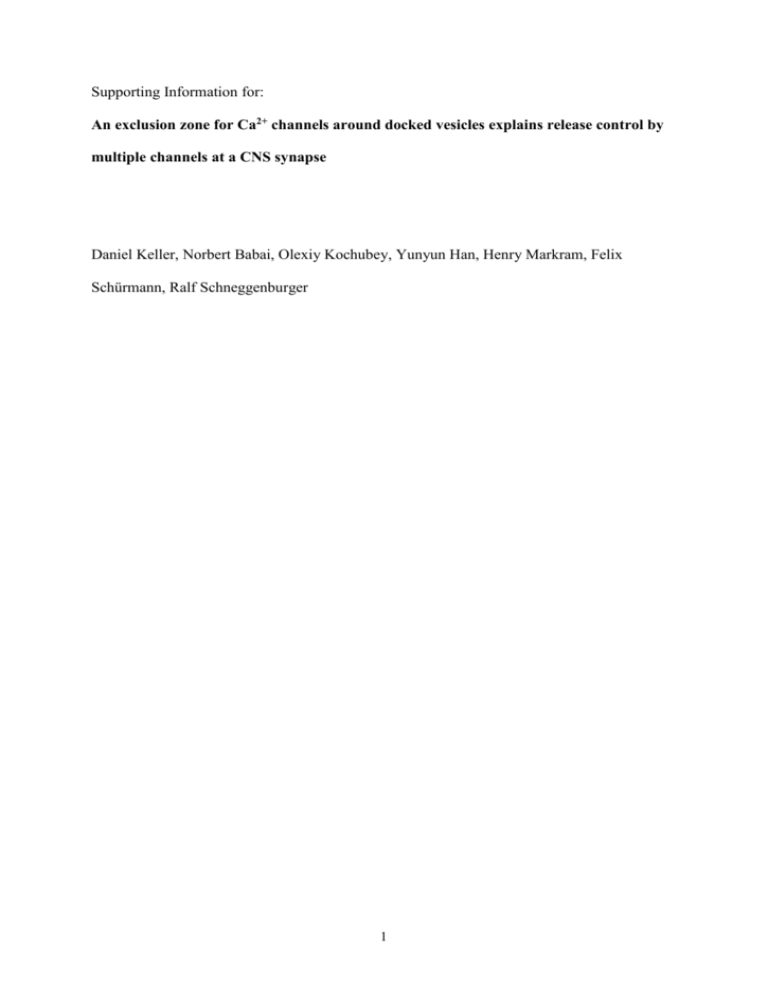
Supporting Information for: An exclusion zone for Ca2+ channels around docked vesicles explains release control by multiple channels at a CNS synapse Daniel Keller, Norbert Babai, Olexiy Kochubey, Yunyun Han, Henry Markram, Felix Schürmann, Ralf Schneggenburger 1 S2 Text. Detailed Justification of model parameters Single Ca2+ channel current. Since the single channel Ca2+ current (iCa) is an important variable in setting the microdomain [Ca2+]i close to an open channel [16], we carefully screened the literature results regarding iCa. Weber et al. 2010 (ref. [31]) showed that L-type currents had iCa of ~ 0.13 at 0 mV and 2 mM [Ca2+]. Variance-mean analysis of presynaptic Ca2+ currents at mossy fiber boutons estimated iCa with 0.13 pA at 0 mV and physiological [Ca2+] (ref. [30]), whereas the corresponding value at the calyx of Held was slightly lower (0.08 pA; ref. [32]). Finally, a recent paper using cell-attached presynaptic recordings estimated the single channel current at 0 mV and 10 mM [Ca2+] with 0.27 pA [41]. Considering a two-fold increase in iCa between 2 and 10 mM [Ca2+] (Church and Stanley, 1996; Schneggenburger et al., 1999), the latter value corresponds to 0.13 pA. Thus, the value of 0.12 pA used here is justified by several recent direct experimental estimates [30-32, 41]. We assumed a linear voltage dependence of the single channel current, with a slope of 2.2 pS. Ca2+ channel gating and AP waveform. We adapted a Hodgkin-Huxley Ca2+ channel model [19] to its direct stochastic counterpart (Fig. 2A). The channel possesses open and closed states, with transitions between them governed by voltage dependent rates. To drive the channels, we fitted the AP recorded at the calyx of Held nerve terminal [19] to a Gaussian function with skew. This "standard AP" departed from -80 mV, had a peak amplitude of +28 mV and a half-width of 0.49 ms (Fig. 2D, top; black trace). To model the effect of recruiting more, or fewer Ca2+ channels, we either prolonged, or shortened the APs (Fig. 2D). Ca2+ sensor. We used a "five site" model of Ca2+ binding and vesicle fusion, as determined experimentally in direct presynaptic Ca2+ uncaging studies at the calyx of Held synapse [8, 22, 36, 37], using the parameters reported in [37]. At the calyx of Held, many published Ca2+ uncaging studies are available [7, 8, 21, 22, 36 - 39]. The studies agree that vesicle fusion is 2 triggered with a high intrinsic Ca2+ cooperativity of release (slope of ~ 4) in a range of ~ 2 10 µM [Ca2+]i, requiring the use of kinetic models with at least 5 Ca2+ ions binding to a release sensor. Some studies additionally investigated Ca2+ control of release at [Ca2+]i < 2 µM, and showed that at low [Ca2+]i, the dose-response curve was less steep, with a slope as low as 0.5 close to resting [Ca2+]i [38, 39] (Kochubey and Schneggenburger, 2011). Nevertheless, the "5-site" model of Ca2+ binding and vesicle fusion [8] should be a valid approximation of the Ca2+ regulation of transmitter release during AP-like Ca2+ influx, which causes microdomain [Ca2+]i signals clearly above 3 µM (Fig. 3B). Importantly, two Ca2+ uncaging studies at the calyx synapse found that the intrinsic Ca2+ sensitivity of vesicle fusion was not changed significantly with development in rats [22], or was only slightly rightward shifted with development in mice [21]. Therefore, the Ca2+ sensitivity of vesicle fusion has been measured and validated by a series of Ca2+ uncaging studies at the calyx of Held synapse. Intracellular Ca2+ buffering. Cells contain endogenous fixed Ca2+ buffer substances with a buffer capacity S of at least ~ 30 [16]; S was found to be ~ 40 at the calyx of Held [33]. Spike-like manipulations of [Ca2+]i with pulsed laser uncaging combined with model calculations have suggested a Kd ≥ 10 µM, and an on-rate kon of ≥ 1.0×108 M-1s-1 for the endogenous buffer [35]; these values were used here (see S1 Table). Given that S = 40 at the calyx of Held [33], a concentration [S] = 400 µM of endogenous buffer was used, since S ≈ [S]/Kd (ref. [16]). We found that a limited diffusional mobility of the endogenous Ca2+ buffer (diffusion coefficient D = 1·10-7 cm2 s-1) was beneficial for speeding the decay of the [Ca2+]i transients (not shown). However, for all simulations shown here (Figs 2 - 6), we assumed that the endogenous buffer was immobile. ATP, a mobile Ca2+ buffer [5], was present at a total concentration of 2 mM in all simulations. Initial simulations showed that without adding 3 ATP, the estimated exclusion zone distance for obtaining pves of 0.1 was larger (40 nm; results not shown). Finally, we assumed the presence of a Parvalbumin (PV)-like Ca2+ buffer with concentration of 50 µM as found experimentally at the calyx synapse [34]; we assumed a diffusional mobility D = 1·10-6 cm2 s-1 for PV (S1 Table). Nevertheless, due to its slow Ca2+ binding kinetics and low concentration, PV did not notably influence the simulated [Ca2+]i transients relevant for fast release. Number and distribution of Ca2+ channels in the "realistic" active zone model: We modelled release at two selected active zones (#5, and #11 in Fig. 1A); the observed density of docked vesicles at these active zones was 100 and 125 ves / µm2, close to the average value (see Fig. 1C; arrows). For both active zones, we assumed a Ca2+ channel density of ~ 280 / µm2. This value is consistent with the reported average value of ~ 240 gold particles / µm2, when Ca2+ channels were detected in freeze fracture replica labelling EM of hippocampal active zones [28]. This density value yielded n = 14 and n = 25 Ca2+ channels for the two example active zones. A recent study using cell-attached recordings at presumed single active zones from calyx of Held nerve terminals, has reported a somewhat larger average number (42 ± 2 channels; ref. [41]. Nevertheless, this value might be an upper limit, since it remains possible that there was a sampling bias towards larger active zones, and that in some cases several active zones were present in the cell-attached recordings. After we fixed the Ca2+ channel density to 280 / µm2, we only modified a single distance parameter, the exclusion zone distance (Fig. 3A, D), or the distance between the supercluster and the nearest vesicle (Figs 3F, 4D). The most important model parameters are listed in S1 Table. 4 References (those not cited in the main text) Church, P.J., and Stanley, E.F. (1996). Single L-type calcium channel conductance with physiological levels of calcium in chick ciliary ganglion neurons. J Physiol 496, 59-68. Kochubey, O., and Schneggenburger, R. (2011). Synaptotagmin increases the dynamic range of synapses by driving Ca2+ - evoked release and by clamping a near-linear remaining Ca2+ sensor. Neuron 69, 736-748. Schneggenburger, R., Meyer, A.C., and Neher, E. (1999). Released fraction and total size of a pool of immediately available transmitter quanta at a calyx synapse. Neuron 23, 399-409. 5
